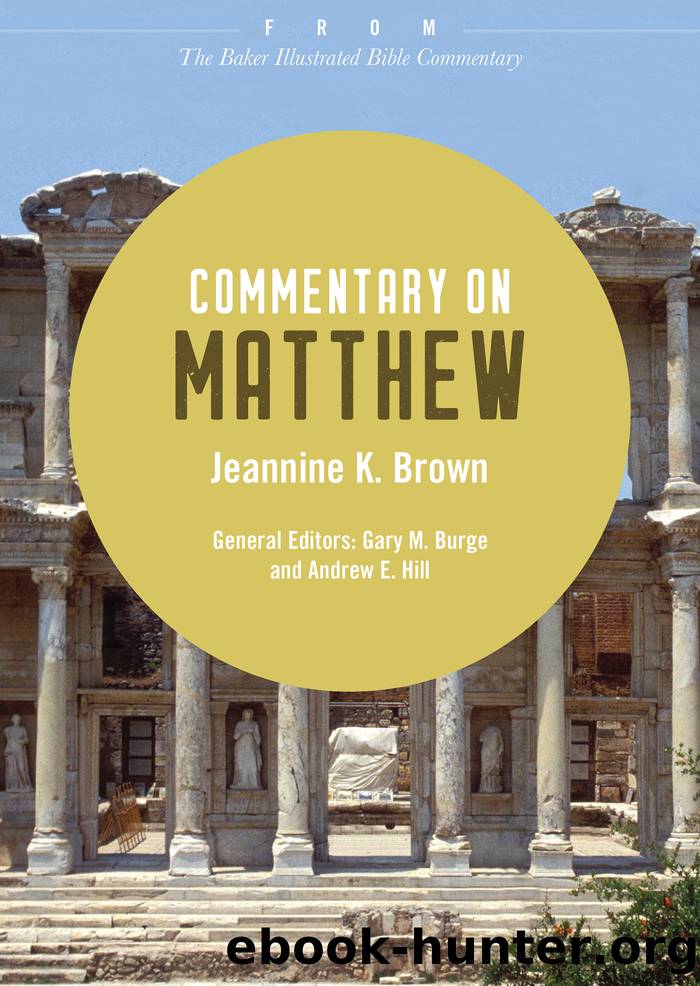Commentary on Matthew by Jeannine K. Brown

Author:Jeannine K. Brown [Burge, Gary M. and Andrew E. Hill]
Language: eng
Format: epub
Tags: Bible Commentary/New Testament, REL006050, REL006070
ISBN: 9781493424634
Publisher: Baker Publishing Group
Published: 2019-10-25T00:00:00+00:00
This area near Capernaum shows the rocky fields and hard paths that would have been familiar to the audience who heard Jesus tell the parable of the soils (Matt. 13:1â9).
Understanding emerges as an important theme in this first parable of Matthew 13 as well as in the two explanations for why Jesus speaks in parables (13:10â17, 34â35), with Scripture cited in both explanations. To answer the disciplesâ question of why he speaks to the crowd in parables (13:10), Jesus cites Isaiah 6:9â10 and distinguishes between three groups, the crowds (his audience in 13:1â35), the disciples who receive additional explanation of his parables (e.g., 13:37â43), and the earlier prophets and righteous ones who longed to hear what the disciples are now hearing (13:16â17). The Isaiah citation comes from that prophetâs call to ministry, in which God indicates that Isaiah will prophesy to an obstinate people, who do not truly hear or see what God is doing (cf. Isa. 6:1â13). In similar fashion, Jesusâs ministry also lands on ears that do not truly hearâthat do not understand (13:11â12). Teaching in parables both hides and reveals, depending on the kind of âsoilâ on the receiving end.
In Matthew 13:34â35, Matthew narrates the reason Jesus speaks in parables by citing Psalm 78:2. Here the reason for Jesusâs speaking in parables to the crowds has to do with revealing what has previously been hiddenâwhat is not easily understood. Parables in this case fit the nature of the truths of the kingdom being revealed, which are difficult to fully grasp (even the disciples do not always understand; 13:36). Once again, the reason for parables is about revelation (to those who are ready and willing to understand; 13:23) and obscurity (for those who are calloused; 13:15). This tension in the chapter is underscored in Jesusâs invitation to the crowds and the disciples (and Matthewâs invitation to his readers) at 13:9 and 13:43 (cf. also 11:15). Though the parables and their truths are difficult to comprehend and accept, anyone with ears among Jesusâs listeners (and in Matthewâs audience) is invited to hear and understand.
In three clearly paired sets of parables, Jesus sets forth the mystery of the kingdom that he has already mentioned. The parables of the mustard seed and the yeast both indicate that, though the kingdom is seemingly insignificant or hidden at present, there will come a time when it will be unmistakable and all-encompassing. By these parables, Matthewâs Jesus communicates the already (present in Jesus) and the not yet of Godâs reign. This same idea is expanded in the parables of the wheat and weeds and the fish and net, which indicate that judgment issuing in the separation of the righteous from the wicked will happen at âthe end of the ageâ (a common phrase in Matthew; see 13:39â40, 49; 24:3; 28:20). The first of these two parables expressly indicates that judgment is withheld in the present (hidden) manifestation of the kingdom because it is not yet clear who is among the righteous (13:30, 38). The
Download
This site does not store any files on its server. We only index and link to content provided by other sites. Please contact the content providers to delete copyright contents if any and email us, we'll remove relevant links or contents immediately.
Fangirl by Rainbow Rowell(8790)
How to Bang a Billionaire by Alexis Hall(7938)
Wonder by R. J. Palacio(7745)
The Space Between by Michelle L. Teichman(6576)
The Thirst by Nesbo Jo(6442)
Assassin’s Fate by Robin Hobb(5856)
Wiseguy by Nicholas Pileggi(5320)
The Night Circus by Erin Morgenstern(5041)
The Kite Runner by Khaled Hosseini(4954)
Paper Towns by Green John(4804)
Bittersweet (True North #1) by Sarina Bowen(4719)
Gerald's Game by Stephen King(4377)
Too Much and Not the Mood by Durga Chew-Bose(4096)
Pillow Thoughts by Courtney Peppernell(4018)
Goodbye Paradise(3452)
Twelve Days of Christmas by Debbie Macomber(3416)
Good by S. Walden(3349)
The Rosie Effect by Graeme Simsion(3210)
The Cellar by Natasha Preston(3078)
